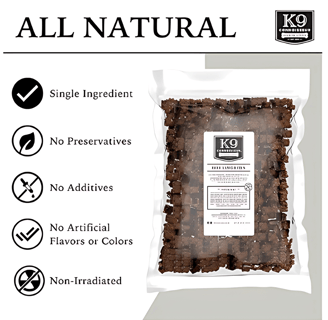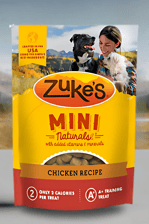I believe in educating dog owners about their breed, unlocking new levels of understanding, and taking that exciting next step together!
High Value vs. Low-Value Dog Treats and Easy Recipes to Try
High-value dog treats, like dehydrated chicken, cheese, or beef lung, are irresistible, smelly, and perfect for training or distracting your pup. Low-value treats, such as kibble or dry biscuits, are better for casual rewards. Use high-value treats sparingly to keep them special and effective. You can easily make your own high-value treats at home with simple recipes like dehydrated chicken, cheesy pupcakes, tuna fudge, or beef lung. These homemade snacks are healthy, cost-effective, and will have your dog wagging their tail in excitement. Balance high- and low-value treats to keep your pup motivated and happy! 🐾.
DOG TREATS
Tiffany Sandquist
6 min read


The Great Dog Treat Debate: High-Value vs. Low-Value and How to Make Your Pup’s Favorite Snacks at Home
Let’s talk about dog treats for a second. Not all treats are created equal. Some are like the fast food of the dog world—your pup will eat them, but they’re not exactly writing home about it. Others? Well, those are the high-value treats. They’re the caviar, the truffles, the “I-would-sell-my-soul-for-this” snacks that make your dog’s eyes light up like it’s Christmas morning.
But what’s the difference between high-value and low-value treats? And how can you make your own high-value treats at home, including the legendary dehydrated beef lung? Buckle up, because we’re diving into the delicious world of dog snacks!
High-Value vs. Low-Value Treats: What’s the Difference?
Think of it like this:
- High-value treats they’re the top-tier, five-star dining experience for your pup. They’re irresistible, smelly, and usually made with real meat, cheese, or fish. Your dog would do anything for these—sit, stay, roll over, maybe even file your taxes if you asked nicely.
- Low-value treats are more like the side dishes at a feast. They’re fine, but they don’t exactly inspire your dog to greatness. These are your basic kibble, dry biscuits, or store-bought treats that your pup might eat if there’s nothing better around.
Here’s a quick breakdown:
High-Value Treats | Low-Value Treats
|------------------------------------|-----------------------------------|
Strong, enticing smell | Mild or no smell
Soft and easy to eat | Crunchy or hard
Made with real meat, cheese, or fish | Often grain-based or processed
Used for training or special rewards | Used for everyday snacking
High-value treats are your go-to for training, distracting your dog during nail trims, or bribing them to stop barking at the neighbor’s cat. Low-value treats are great for casual rewards or just because you love them!
When to Use High-Value vs. Low-Value Treats
- High-value treats: Use these when you need your dog’s undivided attention. Training a new trick? High-value. Introducing your dog to a scary vacuum cleaner? High-value. Trying to get them to stop stealing your socks? Definitely high-value.
- Low-value treats: These are perfect for everyday rewards or when your dog is already calm and focused. Did they sit when you asked? Low-value. Did they look cute for 0.5 seconds? Low-value.
The key is to balance the two. If you use high-value treats all the time, they lose their magic. Save them for the big moments, and your dog will stay motivated.
How to Make Homemade High-Value Treats
If you’re feeling fancy (or just want to save some cash), you can make your own high-value treats at home. Here are four easy recipes that’ll have your dog wagging their tail like a maniac, including the fan-favorite dehydrated beef lung:
1. Chicken Crack (a.k.a. Dehydrated Chicken)
Ingredients:
- Boneless, skinless chicken breasts
Instructions:
1. Preheat your oven to 200°F (93°C).
2. Slice the chicken into thin strips (about ¼ inch thick).
3. Place the strips on a baking sheet lined with parchment paper.
4. Bake for 2-3 hours, flipping halfway through, until the chicken is dry and chewy.
5. Let cool and cut into small pieces. Store in the fridge for up to a week or freeze for longer storage.
Why dogs love it: It’s pure meaty goodness. Enough said.
2. Cheesy Pupcakes
Ingredients:
- 1 cup whole wheat flour
- 1 cup shredded cheddar cheese
- 1 egg
- ¼ cup unsweetened applesauce
Instructions:
1. Preheat your oven to 350°F (175°C).
2. Mix all ingredients in a bowl until a dough forms.
3. Roll the dough into small balls (about 1 inch in diameter) and place them on a baking sheet.
4. Flatten each ball slightly with your fingers.
5. Bake for 15-20 minutes, or until golden brown.
6. Let cool and store in an airtight container.
Why dogs love it: Cheese. Need we say more?
3. Tuna Fudge (Yes, Really)
Ingredients:
- 1 can of tuna in water (do not drain)
- 1 cup whole wheat flour
- 1 egg
Instructions:
1. Preheat your oven to 350°F (175°C).
2. Blend the tuna (with its water), flour, and egg in a food processor until smooth.
3. Spread the mixture into a greased baking dish.
4. Bake for 20-25 minutes, or until firm.
5. Let cool and cut into small squares. Store in the fridge for up to a week.
Why dogs love it: It’s fishy, smelly, and downright irresistible.
4. Dehydrated Beef Lung: The Ultimate High-Value Treat
Beef lung is like the holy grail of high-value treats. It’s stinky, chewy, and dogs go absolutely nuts for it. Here’s how to make it at home:
Ingredients:
- Fresh beef lung (available at most butcher shops or specialty pet stores)
Instructions:
1. Preheat your oven to 200°F (93°C) or set up a food dehydrator.
2. Trim any excess fat or connective tissue from the beef lung.
3. Slice the lung into thin strips or small cubes (about ¼ inch thick).
4. Place the pieces on a baking sheet lined with parchment paper or in your dehydrator trays.
5. Bake or dehydrate for 6-8 hours, flipping halfway through, until the pieces are dry and leathery.
6. Let cool completely and store in an airtight container.
Why dogs love it: It’s chewy, smelly, and packed with flavor. Plus, it’s a natural source of protein and nutrients.
Pro Tips for Using High-Value Treats
- Save them for special occasions. If you give your dog high-value treats all the time, they’ll lose their magic. Use them for training, grooming, or when you need your dog to focus in a distracting environment.
- Keep them small. High-value treats should be bite-sized so your dog can eat them quickly and stay engaged.
- Mix it up. Rotate between different high-value treats to keep your dog guessing (and motivated).
Store-Bought High-Value Treats: The Convenient Option
Sometimes, life gets busy, and you don’t have time to whip up a batch of homemade dehydrated chicken or beef lung. That’s where store-bought high-value treats come in handy! These pre-packaged goodies are designed to be just as irresistible as the homemade versions, making them perfect for training, rewarding good behavior, or just spoiling your pup.
Store-bought high-value treats are typically made with real meat, fish, or cheese, and they’re crafted to have a strong, enticing smell that dogs can’t resist. They’re often soft and easy to chew, which makes them ideal for quick rewards during training sessions. Plus, they come in convenient packaging, so you can toss them in your bag for on-the-go adventures.
When shopping for high-value treats, look for options with simple, high-quality ingredients. Avoid treats with artificial flavors, colors, or fillers. Many brands offer freeze-dried, air-dried, or gently cooked options that retain the natural flavors and nutrients your dog loves.
While store-bought treats might not have the personal touch of homemade snacks, they’re a fantastic backup plan for busy dog parents. Just remember to use them sparingly to keep them special and effective. After all, your dog deserves the best—whether it’s homemade or store-bought! My dog loves Zukes, you can find here on Amazon https://amzn.to/3CzZmFQ and K9 Connoisseur Beef Lung https://amzn.to/4hE0QO3
Final Thoughts
High-value treats are the secret weapon in every dog parent’s arsenal. They’re the key to unlocking your dog’s full potential (and maybe their heart). Low-value treats are great for everyday rewards, but nothing beats a high-value snack when you need your dog to sit up and take notice.
And if you’re feeling fancy, whip up a batch of homemade high-value treats, including the legendary dehydrated beef lung. Your dog will think you’re a culinary genius, and you’ll feel like a hero.









Sit Happens Here
Transforming lives through dog training excellence.
Contact Us
971-218-9622
© 2024. All rights reserved.
